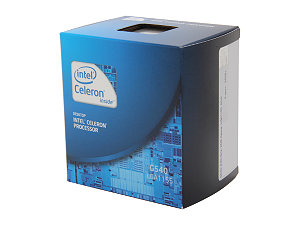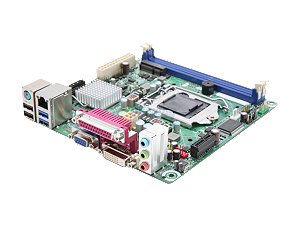Holiday 2012 Small Form Factor Buyer's Guide
by Zach Throckmorton on December 5, 2012 1:55 AM ESTSmall Size, Small Price Tag
While Intel has yet to release Ivy Bridge-based Celeron-class (i.e. cheap) CPUs, I briefly reviewed the Celeron G530's performance in a previous budget buyer's guide. Intel has, however, given its entry-level chips a modest speed bump in that the Celeron G540 and G550 models are often available for a dollar or two more than the G530. Because they are adequate for day-to-day tasks and are priced so low, they remain the kings of the budget CPUs.
 We've paired the Celeron G540 with one of the least expensive ITX Socket 1155 motherboards, Intel's BOXDH61DLB3. While there are less expensive boards, reliability issues prevent us from giving them the nod in this buyer's guide. Intel's entry-level ITX model offers basic features as well as USB 3.0 ports. Note that it does not have a PCIe x16 lane, instead offering a single PCIe x1 lane. This is likely not a concern for a budget, general office productivity box that will likely never need a video card installed but might need a wireless adapter card. Furthermore, its SATA ports are limited to SATA II speeds, so the newest SSDs that use SATA III will be crippled. Again, though, this is a budget system and something has to give. If you need a PCIe x16 lane and SATA III ports, you'll need to step up to a board like ASRock's B75M-ITX or ASUS' P8H77-I.
We've paired the Celeron G540 with one of the least expensive ITX Socket 1155 motherboards, Intel's BOXDH61DLB3. While there are less expensive boards, reliability issues prevent us from giving them the nod in this buyer's guide. Intel's entry-level ITX model offers basic features as well as USB 3.0 ports. Note that it does not have a PCIe x16 lane, instead offering a single PCIe x1 lane. This is likely not a concern for a budget, general office productivity box that will likely never need a video card installed but might need a wireless adapter card. Furthermore, its SATA ports are limited to SATA II speeds, so the newest SSDs that use SATA III will be crippled. Again, though, this is a budget system and something has to give. If you need a PCIe x16 lane and SATA III ports, you'll need to step up to a board like ASRock's B75M-ITX or ASUS' P8H77-I.
Housing the budget build is Apex's MI-008, a longtime favorite of mine for cheap ITX systems. It's reasonably well-constructed, and comes with a serviceable 250W power supply. Its thermals aren't particularly impressive, but for a system lacking a discrete graphics card and running a Sandy Bridge Celeron, it doesn't need to have the best airflow. The MI-008 can accommodate full size hard and optical drives, which helps keep costs down.
 As for the memory, a single 4GB stick of budget DDR3-1333MHz is sufficient for basic computing in Windows 7 64-bit (or Windows 8 if you want to go that route), and leaves an open slot so upgrading to 4GB in the future will be cheap and easy. Hard drive and solid state drive prices are especially dynamic this time of year, making recommendations difficult. While day to day hard drive prices remain elevated in the wake of the notorious Thailand floods, sale prices are beginning to get back to where they were before hard drive supplies were disrupted late last year. If you're patient and pay attention to prices, you will likely be able to snag a mainstream 7200RPM 1TB hard drive for $60 or less. If you don't need much local storage, a 64GB SSD will give you an enormous performance boost for about the same price.
As for the memory, a single 4GB stick of budget DDR3-1333MHz is sufficient for basic computing in Windows 7 64-bit (or Windows 8 if you want to go that route), and leaves an open slot so upgrading to 4GB in the future will be cheap and easy. Hard drive and solid state drive prices are especially dynamic this time of year, making recommendations difficult. While day to day hard drive prices remain elevated in the wake of the notorious Thailand floods, sale prices are beginning to get back to where they were before hard drive supplies were disrupted late last year. If you're patient and pay attention to prices, you will likely be able to snag a mainstream 7200RPM 1TB hard drive for $60 or less. If you don't need much local storage, a 64GB SSD will give you an enormous performance boost for about the same price.
While Windows 7 64-bit remains the de facto standard operating system for PCs, note that Windows 8 64-bit is now also available. Note that for this budget build, the $92 Windows license accounts for about 25% of the total cost. If you're on an extremely tight budget, or simply want to explore other operating systems, be sure to check out a free OS like Ubuntu.
| Component | Product | Price |
| Case | Apex MI-008 | $48 |
| Power supply | (included with case) | |
| CPU | Intel Celeron G540 2.5GHz dual-core | $45 |
| Motherboard | Intel BOXDH61DLB3 mITX | $72 |
| RAM | G.Skill Value 4GB DDR3-1333MHz | $18 |
| Hard drive | Seagate Barracuda 1TB ST1000DM003 | $70 |
| SSD alternate | Intel 330 Series 60GB | $70 |
| Optical drive | Samsung SH-224BB DVD burner | $16 |
| Operating system | Windows 7 64-bit Home Premium OEM | $92 |
| Total: | $361 |
Check the next page for our small form factor file server build.










74 Comments
View All Comments
Avendit - Thursday, December 6, 2012 - link
Its not so much signal issues I've had as earthing problems. Using a copper co-ax for digital out on my media PC gave a loud pop every time the audio fired up and dts sync'd. Switch to optical and the problem goes away. I could see the same thing being possible with HDMI.It might be something unique to systems a size down from these - I'm talking systems with laptop style power bricks, hence the earthing problem I think. But its also passive and does just enough for a media PC, albeit with most content stored over the network.
Avendit
ender8282 - Thursday, December 6, 2012 - link
I took the comment to refer to better isolation of the audio system. I believe that the fear is that a a copper cable running from the computer to the audio system could introduce a ground loop and cause issues.Guspaz - Thursday, December 6, 2012 - link
HDMI is prone to interference, digital or otherwise. If you've ever suffered from interference on an HDMI cable, you'd see it as coloured snow on the image. It's hard to describe, it's like, imagine you have a large number of stuck pixels, except their location changes every frame.I get this from my PS3 to my U2711 when using deep colour. It requires more bandwidth, so the signal is less robust (generally, the higher bandwidth your HDMI signal, the more prone to interference). I'm using a rather thin cable (28AWG), so even though the total length of the cable run isn't very long (~15 feet total), there's some interference problems due to the high bandwidths involved.
I have no such problems from my PS3 to my projector, despite using a much longer cable (PS3 -> HDMI switch -> U2711 or projector), because the cable going from my switch to my TV is a MUCH thicker cable.
Midwayman - Thursday, December 6, 2012 - link
Even two years ago you had to work hard not to buy a unit without HDMI. No reason to eliminate choices, but if you have to pick one or the other, HDMI is the future. Granted HDMI is a pretty crappy standard in many ways, but its what consumer gear uses for better or worse.Guspaz - Thursday, December 6, 2012 - link
HDMI cables using RedMere chips have similar thicknesses to good optical TOSLINK cables at up to 15 chips. They do cost a lot more, but they're still available at MonoPrice, so at least you know the premium isn't ripping you off.Normally, a typical HDMI cable uses 28AWG conductors for up to 15 feet, RedMere can use 36AWG conductors for up to the same distance. That's a pretty enormous reduction in size, and it should be more resistant to interference to boot.
Over 15 feet, though... At 30 feet, regular HDMI is going to be something like 24AWG, while RedMere bumps it up to 28AWG.
HisDivineOrder - Monday, December 10, 2012 - link
Pssst. AnyDVD HD+XBMC 12 Frodo.
You're welcome.
lmcd - Thursday, December 6, 2012 - link
I'm pretty sure even an AMD A4 can do the off-frame rates more accurately than Intel's IGPs, so I'd consider an AMD build in that case.Metaluna - Thursday, December 6, 2012 - link
Personally, for HTPC I prefer a slim desktop-style microATX case, like the Antec NSK2480 or equivalent Silverstone. Plenty of room inside for a large GPU and/or tuner card, and several drives. Much easier to work in, and, unlike these wierd shoebox cases, they actually stack nicely with other HT components like receivers or BD players.drewpsu - Friday, December 7, 2012 - link
Thanks to network tuners from an HDHomeRun, my HTPC is mini-ITX without having to worry about internal tuner cards.cyrusfox - Wednesday, December 5, 2012 - link
When it comes to budget itx builds(media center or file server), I really think the new Celeron Mobile 847(SB) boards Rock. I got one coming to my place tomorrow to be my tv box.Check'er out
http://www.newegg.com/Product/Product.aspx?Item=N8...
Sandybridge mobile performance for $80(superbiiz), Sure it is only 1.1 GHz - 2 cores, but should be able to handle 1080p hulu or netflix streams and the TDP at 17W, tiny, perfect for those insane small ITX cases like a Wesena itx2 case or heatsink streacom case(silent media box). Goodbye brazos, its been a good 23 months.